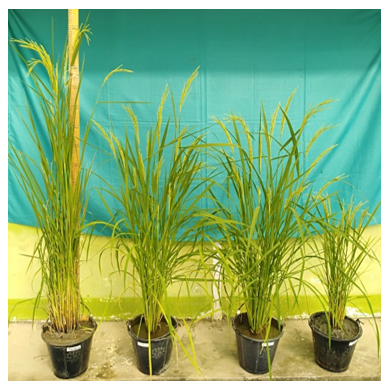Linkage map construction and QTL identification for yield related traits of rice (Oryza sativa L.)
Main Article Content
Khin Swe Hlaing Tun
Than Myint Htun
Nyo Mar Htwe
Myint Aye
Akshay Talukdar
Min San Thein
The study was undertaken to construct a linkage map and to identify the QTLs for heading date, plant height, and culm strength using a F2 population derived from Ayeyarmin/IR 64, two varieties distinctly different in heading date and plant height. A total of 233 F2 individuals were genotyped using 70 SSR primers, and phenotypic data were collected for heading date, plant height and culm strength traits. Fifty-four out of 70 marker loci were mapped across twelve rice chromosomes spanning a total map length of 1592.30 cM with an average distance of 29.49 cM between adjacent marker loci using MAPMAKER/EXP 3. Composite interval mapping for QTL analysis was conducted with 1000 permutation time at 0.05 probability level using WinQTL Cartographer version 2.5. One major QTL for heading date was mapped between marker RM204 and RM50 on chromosome 6. One major QTL for culm strength was mapped between marker RM1003-RM5931, and two major QTLs for plant height were mapped between RM84-RM1003 and RM1003-RM5931 on chromosome 1. The molecular markers linked to the major QTLs could be potentially used in marker-assisted selection for the rainfed rice improvement breeding program.
Anitha Shalini, S. (2015). Identification of molecular markers associated with culm strength in rice (Oryza sativa l.) using selective line genotyping (Doctoral dissertation). Telangana State Agricultural University, Rajendranagar, Hyderabad.
Ansari, M. U. R., Shaheen, T., Bukhari, S., & Husnain, T. (2015). Genetic improvement of rice for biotic and abiotic stress tolerance. Turkish Journal of Botany, 39(6), 911-919.
Collard, B. C., Jahufer, M., Brouwer, J., & Pang, E. (2005). An introduction to markers, quantitative trait loci (QTL) mapping and marker-assisted selection for crop improvement: the basic concepts. Euphytica, 142(1), 169-196.
Hua, Z., Xu, L., Yongyi, Y., Ning, X., & Fangyin, Y. (2018). Mapping of Hd-6-2 for Heading Date Using Two Secondary Segregation Populations in Rice. Rice Science, 25(3), 161-168.
Kashiwagi, T. J. E. (2014). Identification of quantitative trait loci for resistance to bending-type lodging in rice (Oryza sativa L.). Euphytica, 198(3), 353-367.
Khahani, B., Tavakol, E., Shariati, V., & Rossini, L. (2021). Meta-QTL and ortho-MQTL analyses identified genomic regions controlling rice yield, yield-related traits and root architecture under water deficit conditions. Scientific reports, 11(1), 6942.
Kumar, J., Gupta, D. S., Gupta, S., Dubey, S., Gupta, P., & Kumar, S. (2017). Quantitative trait loci from identification to exploitation for crop improvement. Plant Cell Reports, 36(8), 1187-1213.
Lander, E. S., Green, P., Abrahamson, J., Barlow, A., Daly, M. J., Lincoln, S. E., & Newburg, L. (1987). MAPMAKER: an interactive computer package for constructing primary genetic linkage maps of experimental and natural populations. Genomics, 1(2), 174-181.
McCouch, S. J. R. G. N. (1997). Suggestions for QTL nomenclature for rice. Rice Genetic Newsletter, 14, 11-13.
Murray, M., & Thompson, W. F. (1980). Rapid isolation of high molecular weight plant DNA. Nucleic acids research, 8(19), 4321-4326.
Sahu, V. K., Sunil, K. N., Vishwakarma, A. K., Verulkar, S., & Chandel, G. (2017). QTL hotspots detected for yield contributing traits in rice (Oryza Sativa L.) using composite interval mapping analysis. Biosciences Biotechnology Research Asia, 14(1), 329-341.
Singh, B., & Singh, A. K. (2015). Marker-assisted plant breeding: principles and practices: Springer.
Suji, K. K., Biji, K. R., Poornima, R., Prince, K. S. J., Amudha, K., Kavitha, S., . . . Babu, R. C. (2012). Mapping QTLs for Plant Phenology and Production Traits Using Indica Rice (Oryza sativa L.) Lines Adapted to Rainfed Environment. Molecular biotechnology, 52(2), 151-160. doi:10.1007/s12033-011-9482-7
Tripathi, J., Thagele, S. N., Sharma, A. K., Tripathi, N., Tripathi, P., & Singh, A. K. (2018). Parental polymorphism survey for drought tolerance in rice by using SSR marker. Journal of Biotechnology and Biochemistry, 4(5), 82-86.
Wang, S. (2007). Windows QTL cartographer 2.5. http://statgen ncsu. edu/qtlcart/WQTLCart. Html.
Xiong, L., Liu, K., Dai, X., Xu, C., Zhang, Q. J. T., & Genetics, A. (1999). Identification of genetic factors controlling domestication-related traits of rice using an F2 population of a cross between O. sativa and O. rufipogon. Genetics, 98(2), 243-251.
Xu, Y. (2010). Molecular Plant Breeding, Wallingford. UK: CAB International.
Yadav, S., Singh, U. M., Naik, S. M., Venkateshwarlu, C., Ramayya, P. J., Raman, K. A., & Kumar, A. (2017). Molecular mapping of QTLs associated with lodging resistance in dry direct-seeded rice (Oryza sativa L.). Frontiers in Plant Science, 8, 1431.
Khin Swe Hlaing Tun , Rice Research Center, Department of Agricultural Research, Myanmar
Assistant Research Officer, Rice Research Center, Department of Agricultural Research, Myanmar
Than Myint Htun , Yezin Agricultural University, Myanmar
Professor, Department of New Genetics, Advanced Center for Agricultural Research and Education, Yezin Agricultural Research, Myanmar
Nyo Mar Htwe , Yezin Agricultural University, Myanmar
Professor, Department of Capacity Building, Advanced Center for Agricultural Research and Education , Yezin Agricultural Research, Myanmar
Myint Aye , Yezin Agricultural University, Myanmar
Associate Professor, Department of New Genetics, Advanced Center for Agricultural Research and Education, Yezin Agricultural Research, Myanmar
Akshay Talukdar , Indian Agricultural Research Institute, India
Principal Scientist, Division of Genetics, Indian Agricultural Research Institute, New Delhi 110012, India
Min San Thein , Department of Agricultural Research, Myanmar
Deputy Director General, Department of Agricultural Research, Myanmar








